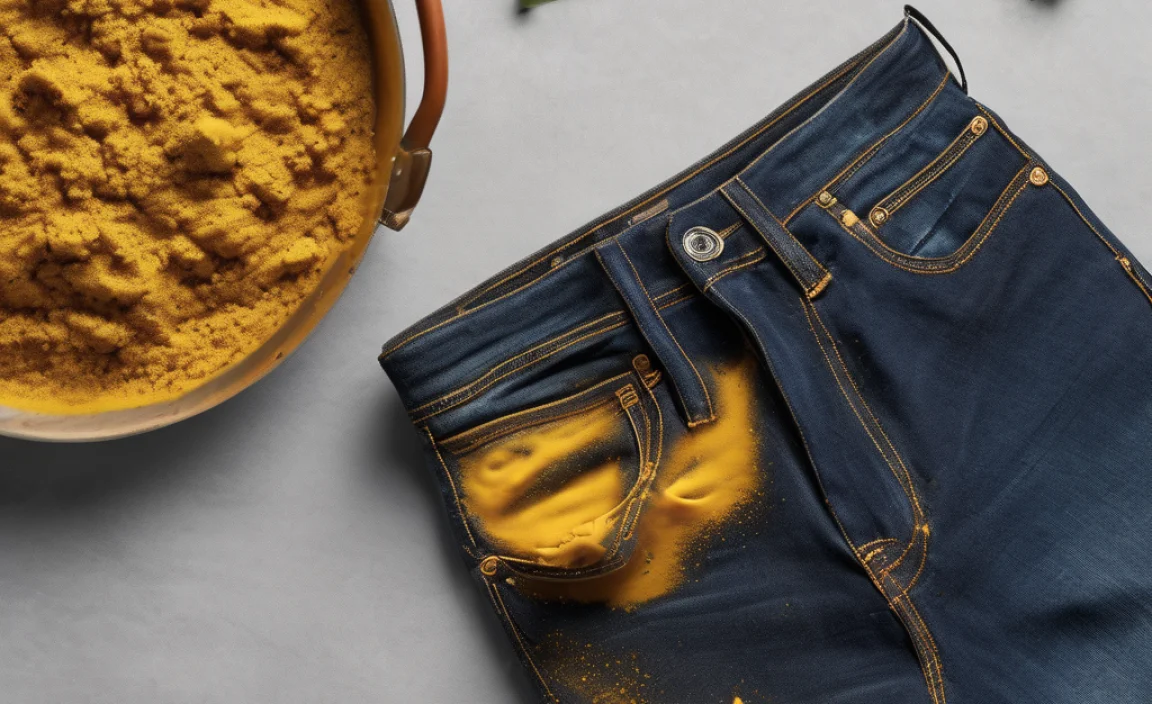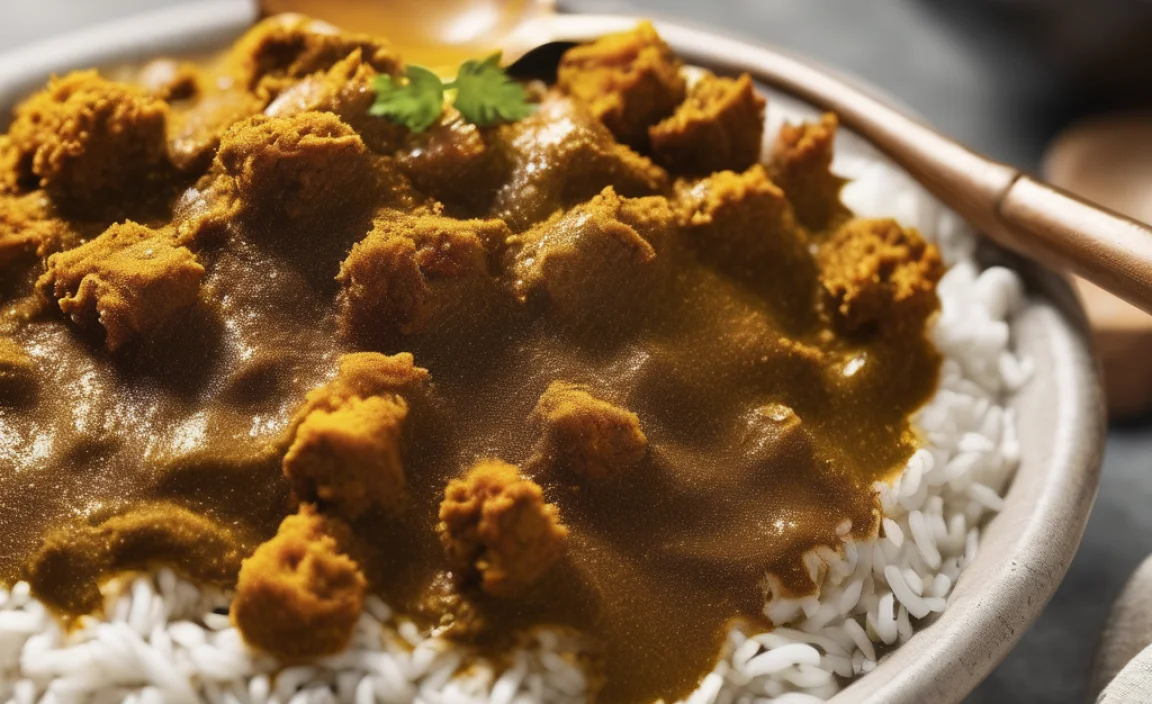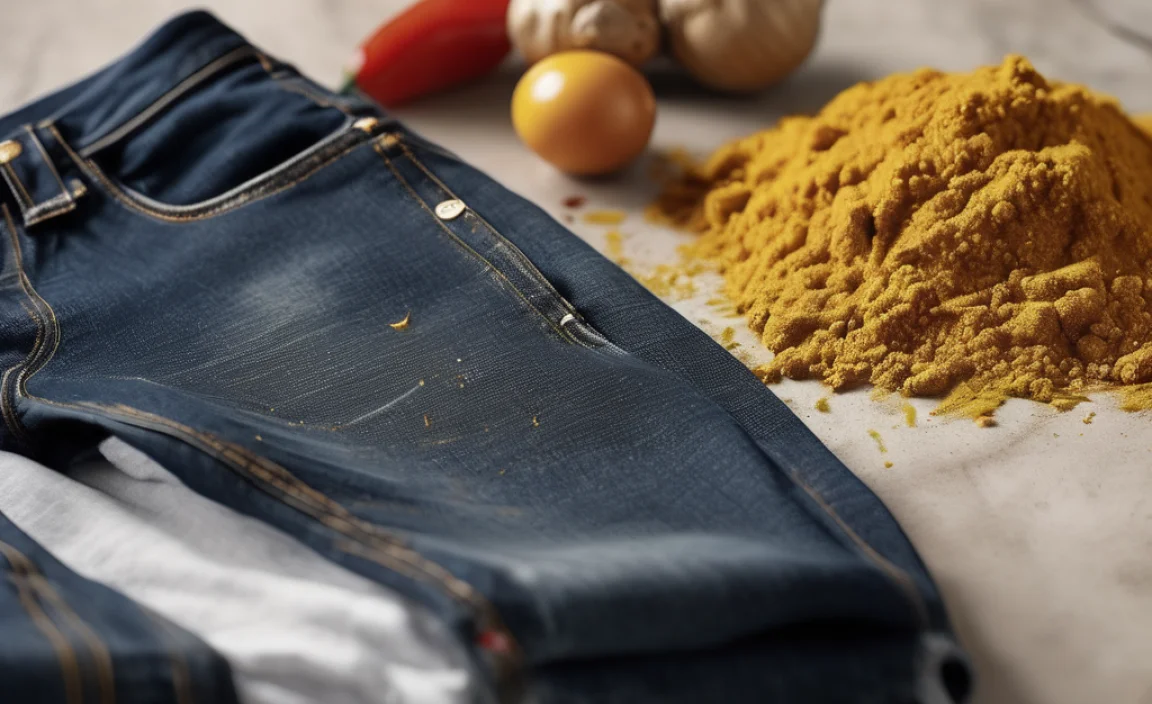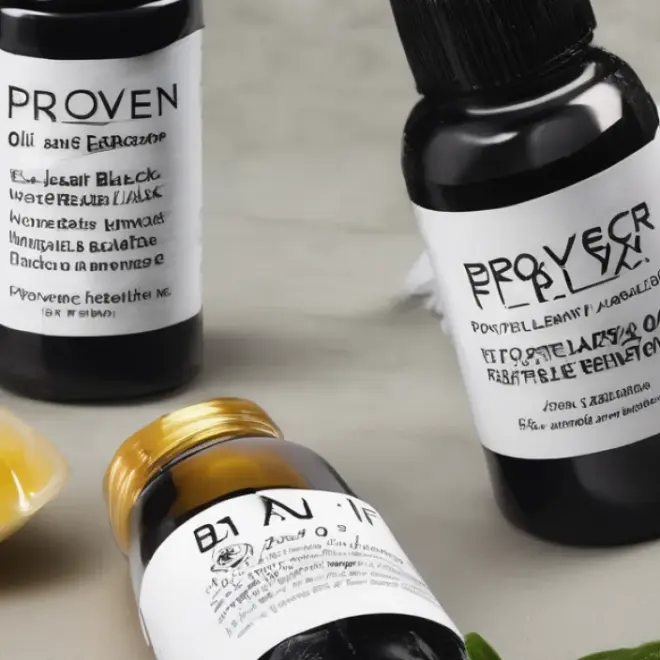Quick Summary: Stains from curry on dark wash jeans can be tricky, but not impossible. This guide offers simple, effective methods using common household items to help you lift those stubborn turmeric and spice marks without damaging your favorite denim. Act fast for the best results!
Oh, the deliciousness of a good curry! But then comes the inevitable splash. That vibrant yellow or orange stain from turmeric, a key ingredient in many curries, can seem like a permanent resident on your beloved dark wash jeans. Don’t despair! It’s a common laundry mishap, and with the right approach, those frustrating stains can be a thing of the past. We’ll walk through proven methods using everyday items that are gentle on your denim but tough on stains. Let’s get those jeans looking as good as new, ready for your next adventure (or just your next meal!).
Understanding Curry Stains on Denim

Curry stains get their notorious reputation primarily from turmeric. Turmeric contains a potent natural pigment called curcumin, which is a strong chromophore, meaning it readily absorbs and reflects light in a way that makes it highly visible – and unfortunately, very persistent. When this oil-soluble pigment comes into contact with fabric, especially one with a textured weave like denim, it can penetrate the fibers deeply. The dark wash of your jeans usually offers a good camouflage, but turmeric’s intensity often breaks through, leaving tell-tale yellow or orange marks.
The type of fabric, the age of the stain, and the ingredients in the curry itself (spices, oils, dairy) all play a role in how difficult a stain will be to remove. Fresh stains are always easier. Oily components in curry can also set the stain, making it harder to lift without breaking down both the pigment and the grease.
Why Dark Wash Jeans Present a Unique Challenge

Dark wash jeans are a wardrobe staple for a reason – they’re versatile and stylish. However, their deep dye can sometimes make stain removal a bit more delicate. While the dark color might hide minor blemishes, aggressive stain removal techniques intended for lighter fabrics could potentially cause fading or uneven color loss on dark denim. This means we need solutions that are effective at lifting the stain without stripping the dye. Our goal is to target the stain’s pigment and oil without compromising the integrity of your jeans’ color and fabric.
Gather Your Stain-Fighting Arsenal

Before you dive in, it’s helpful to have a few common household items ready. The good news is you likely already have most of these on hand:
- Mild Dish Soap: Excellent for breaking down grease and oil.
- White Vinegar: A natural acid that can help lift stains and act as a mild bleach.
- Baking Soda: A gentle abrasive and deodorizer that can absorb stains.
- Rubbing Alcohol (Isopropyl Alcohol): Effective for dissolving certain pigments and oils.
- Hydrogen Peroxide (3% solution): A mild bleaching agent that’s generally safe for colors, but always test first.
- Enzyme-based Laundry Detergent: Specifically designed to break down organic stains like food and grease.
- Clean White Cloths or Paper Towels: For blotting and applying solutions.
- A Soft Brush (like an old toothbrush): For gently working solutions into the stain.
- Cold Water: Essential for the initial rinsing and for most washing processes to prevent setting the stain.
Step-by-Step Guide to Removing Curry Stains

The key to tackling curry stains on dark wash jeans is to act quickly and be patient. Here’s a proven method that prioritizes stain removal while protecting your denim:
Step 1: Act Fast and Blot
The moment you notice a curry spill, grab a clean cloth or paper towel and gently blot the stained area. Do NOT rub. Rubbing will push the stain deeper into the fabric fibers and can spread it. Your goal here is to absorb as much of the excess curry as possible.
Step 2: Rinse with Cold Water
Turn the jeans inside out and rinse the stained area thoroughly with cold water from the back. This helps to push the stain out of the fabric rather than further in. Avoid hot water, as heat can set protein-based stains and curry oils.
Step 3: Pre-treat with Dish Soap
Apply a generous dab of mild liquid dish soap directly onto the stain. Dish soap is fantastic at cutting through the oily components of curry. Gently work the soap into the stain with your fingers or a soft brush. Let it sit for about 5-10 minutes.
Step 4: Apply Your Chosen Stain Remover (Choose One Method)
Now it’s time to tackle the pigment. Select one of the methods below. Always test any solution on an inconspicuous area of the jeans first (like an inside seam) to ensure it doesn’t affect the dye.
Method A: White Vinegar and Baking Soda Paste
Mix 1 part white vinegar with 2 parts baking soda to create a paste. Apply this paste generously over the stained area. Let it sit for at least 15-30 minutes, or until the paste dries. The vinegar helps break down the stain, and the baking soda absorbs it.
Method B: Hydrogen Peroxide (for stubborn stains)**
This method is more potent and should be used with caution on dark denim. Dampen a clean white cloth with a 3% hydrogen peroxide solution. Gently dab the stain with the dampened cloth. You may see the stain begin to lift immediately. Do not saturate the fabric. You may need to repeat this a few times. It’s crucial to rinse thoroughly after using hydrogen peroxide.
A study published in the Journal of the American Oil Chemists’ Society highlighted the effectiveness of various surfactants and oxidizing agents in stain removal, with gentle peroxides showing promise in breaking down complex organic compounds found in food stains.
Method C: Rubbing Alcohol
Dampen a clean white cloth with rubbing alcohol. Dab the stain carefully. The alcohol can help lift the pigment. This is often effective for oil-based stains and pigments.
Step 5: Gently Agitate and Rinse
After letting your chosen pre-treatment sit, gently agitate the stained area with your fingers or a soft brush. Then, rinse thoroughly with cold water. You should start to see the stain fading.
Step 6: Launder as Usual (with a Caveat)
Once you’ve pre-treated and rinsed, wash the jeans as you normally would, using your regular laundry detergent and the cold water setting. Inspect the jeans carefully before putting them in the dryer. If the stain is still visible, do NOT put them in the dryer. Heat from the dryer will set the stain permanently.
Step 7: Repeat if Necessary
If the stain persists after the first wash, repeat the pre-treatment and washing steps. You might need to try a different pre-treatment method or simply be more patient and repeat the process several times. Some stubborn stains require multiple treatments.
Important Considerations for Dark Wash Denim

Dark wash jeans can be sensitive to harsh chemicals. Here are a few tips to keep in mind:
- Always Test First: Before applying any cleaning solution to the main stain, test it on an inside seam or hem. This will show you if the solution causes the dye to fade or bleed.
- Avoid Bleach: Chlorine bleach is too harsh for dark denim and will likely cause significant color loss and damage. Stick to gentler options like hydrogen peroxide if you need a bleaching agent.
- Work from the Outside In: When treating a stain, start from the edge of the stain and work your way towards the center. This helps prevent the stain from spreading.
- Patience is Key: Deep-set or large curry stains might not disappear after one attempt. Be prepared to repeat the process.
Alternative Methods and Natural Solutions
When you want to avoid commercial stain removers or have run out of your usual supplies, several natural alternatives can be surprisingly effective:
Lemon Juice
Lemon juice has natural bleaching properties. Apply fresh lemon juice directly to the stain and let it sit in the sun for a few hours. The sun’s rays combined with the citric acid can help lift the stain. Rinse thoroughly afterwards.
Salt and Water Paste
For fresh stains, a paste made of salt and cold water can work. Apply the paste to the stain, let it sit for a while, then gently scrape it off and rinse.
Milk Soak
Some people have found success soaking stained fabric in milk. While less scientifically proven for curry specifically, milk can help lift certain kinds of food-based stains due to its fat content breaking down some elements.
When to Seek Professional Help
If, after multiple attempts with home remedies, the stain remains stubbornly visible, or if your jeans are particularly expensive or delicate, it might be time to consult a professional dry cleaner. They have access to specialized solvents and techniques that can often tackle stains that are resistant to home treatments. Be sure to point out the stain and mention what you’ve already tried to do to remove it.
Preventative Measures: Avoiding Future Curry Catastrophes
Prevention is always better than cure! Here are a few tips to minimize future curry disasters:
- Wear an Apron: A simple kitchen apron is your best defense while cooking or eating messy meals.
- Dine with Care: If you’re eating curry outside the home, be mindful of your surroundings and consider using a napkin strategically.
- Pre-treat “Vulnerable” Clothing: For items you wear often while cooking or know are prone to stains, consider applying a stain-repellent spray.
- Keep a Stain Stick Handy: For immediate attention on the go, a portable stain remover stick can be a lifesaver.
Understanding Stain Removal Science: A Quick Look
Stain removal is essentially chemistry at work. Different types of stains require different approaches:
- Grease/Oil Stains: Require surfactants (like dish soap) to break down and emulsify the oil so it can be washed away.
- Pigment Stains: Can often be lightened or removed by oxidizing agents (like hydrogen peroxide) that break down the colored molecules.
- Protein Stains: Are best treated with enzymes and cold water, as heat can cause them to set.
Curry stains are often a combination, with oils carrying pigments, making a multi-pronged approach (like dish soap followed by a mild oxidizer) very effective. For more in-depth information on fabric care and stain removal, resources like the Toms Chick Stain Removal Guide offer comprehensive insights.
Frequently Asked Questions About Curry Stains on Jeans
Q1: How quickly should I treat a curry stain on my jeans?
You should treat a curry stain immediately for the best chance of complete removal. Fresh stains are much easier to lift than dried-in ones.
Q2: Can I use regular laundry detergent on a curry stain?
Regular laundry detergent is good for washing, but for pre-treating, a detergent with enzymes specifically designed to break down food and grease will be more effective. Always pre-treat before washing.
Q3: Will white vinegar damage my dark wash jeans?
White vinegar is generally safe for most fabrics, including dark wash jeans, when used in moderation and diluted. Always do a patch test first on an inconspicuous area to ensure it doesn’t cause fading.
Q4: Is it safe to put jeans with a curry stain in the dryer?
Absolutely not! Never put stained clothing in the dryer. The heat from the dryer will permanently set the stain into the fabric fibers, making it nearly impossible to remove.
Q5: What if the stain is old and dried on?
Older, dried-on stains are more challenging but not hopeless. You may need to soak the stained area for a longer period (several hours or overnight) in a solution of cold water with an enzyme-based detergent or try repeatedly applying the chosen pre-treatment method before washing.
Q6: Can I use a colored cloth to apply stain remover?
No, always use clean, white cloths or paper towels. Colored cloths could transfer their dye to your jeans, creating a new problem.
Q7: Will baking soda help remove the smell of curry from my jeans?
Yes, baking soda is a natural odor absorber. When used in a paste or even as part of the washing process, it can help neutralize lingering smells associated with food stains.
Conclusion: Bringing Your Jeans Back to Life
Dealing with a curry stain on your dark wash jeans can feel like a laundry emergency, but it’s a solvable one. By acting swiftly and employing the right techniques with everyday items like dish soap, white vinegar, or even hydrogen peroxide (with care), you can effectively lift those vibrant turmeric marks. Remember to always rinse with cold water, avoid heat until the stain is gone, and be patient. With a little effort and the right know-how, your favorite dark wash jeans can be restored, banishing the stain and ready for you to wear with confidence again.











